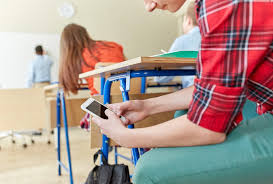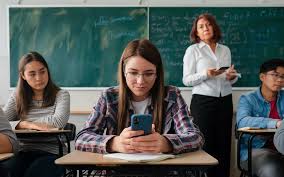
INDIANA – As a school social worker, one of the most frustrating parts of my job is when I’m in the middle of a session with a student, and they take out their cell phone and start texting as if I don’t notice or exist. When I tell them to put their phone away, they protest as if it’s a life-or-death situation.

How did I survive middle school and high school without a cell phone? I didn’t get my first phone until I was a freshman in high school, and it was so difficult to handle I barely used it. But somehow, I survived, and I’m still here to tell the tale.
Some issues are difficult for students to ignore when using cell phones. There has been a noticeable increase in depression and mental health concerns among children who spend their days (and nights) gazing at the bright white screen in front of them. Countless hours spent watching TikTok and arguing back and forth over Snapchat have made it difficult for students to focus on studies, friends, and family.
Many of my students have told me they don’t communicate often with their parents because they lock themselves in their rooms and watch YouTube or chat with friends on social media during their downtime. This chronic behavior is taking away quality family time and interfering with their ability to complete meaningful homework or chores at home. I’ve noticed that when a student’s phone is taken away from them at school, the student reacts like a junkie who can’t get a fix. Many students come into my office crying because a teacher took away their phone.

Since 2015, more and more teenagers have reported feeling lonely. This has not escaped my attention at the middle school where I work. It has been alarming to see the social skills of many students atrophy over the past few years. Many students seem to have forgotten how to start a conversation with their peers and would rather sit alone in silence than interact with their schoolmates. While on lunch duty, I routinely observe many students burying their faces in their cell phones instead of socializing with their peers.
I am not advocating a complete ban on cell phones. Students may need their phones for various reasons, but some common-sense solutions exist. The student fixation on cell phones has led me to conclude that it would be in the best interest of teachers, administrative support staff, and especially the students if we had them keep their cell phones in their lockers during classroom hours.

Another solution might include issuing a bin to each classroom. Students could leave their phones in the container after turning them off for the duration of the class. I think that would help both teachers and students resolve this sensitive issue. There is no easy fix, but ignoring the problem is not contributing to our youth’s well-being or academic excellence.

Heidi Mikac, MSW, LSW, is a Youth First Mental Health Professional at Paul Hadley Middle School in Morgan County. Youth First, Inc., is a nonprofit dedicated to strengthening youth and families. Youth First provides over 100 highly trained mental health professionals (primarily master’s level social workers), prevention programs, parent engagement coordinators, and bilingual support personnel to 126 schools across 14 Indiana counties. Over 53,000 youth and families per year are served by Youth First’s school-based social work and community programs that promote mental health, prevent substance misuse, and maximize student success. To learn more about Youth First, visit youthfirstinc.org or call 812-421-8336.



